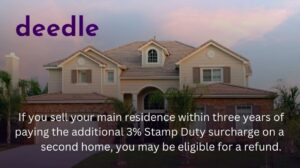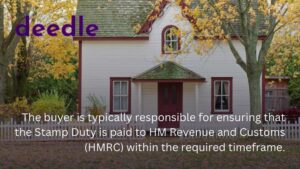Stamp Duty is a tax imposed by the government on certain types of transactions, such as purchases of property over £250,000. It is applicable in England, Wales, and Northern Ireland. The tax is calculated based on the value of the transaction and is usually paid by the buyer.
There are certain circumstances where you may be eligible to reclaim all or a portion of the Stamp Duty tax paid. This article aims to explain how stamp duty claim backs work, as well as any additional pieces of information you may have to keep in mind when making your claim.
How Much Is Stamp Duty in the UK?
Stamp duty in the UK will depend on the price of your home. Just like when you pay income tax, there is a certain portion of value which is non-taxable, then above that you are taxed in bands.
| Property or lease premium or transfer value | SDLT rate |
|---|---|
| Up to £250,000 | Zero |
| The next £675,000 (the portion from £250,001 to £925,000) | 5% |
| The next £575,000 (the portion from £925,001 to £1.5 million) | 10% |
| The remaining amount (the portion above £1.5 million) | 12% |
Source: Gov.uk
For example, for a house priced at £300,000, here’s how the SDLT would be calculated:
- 0% on the first £125,000 = £0
- 2% on the portion between £125,001 and £250,000 (£300,000 – £250,000) = £2,500
Therefore, for a £300,000 house, the SDLT owed would be £2,500.
Can I Claim a Refund on Stamp Duty?
Yes, there are some circumstances where you may be able to claim a refund on Stamp Duty. These include:
Second Home Stamp Duty Refund
If you sell your main residence within three years of paying the additional 3% Stamp Duty surcharge on a second home, you may be eligible for a refund. The claim must be made within specific timeframes, depending on the date of the property sale and Stamp Duty filing.
Stamp Duty Refund for Properties With an Annexe
Properties with a self-contained annexe on their grounds are now considered a single home if the main building represents at least two-thirds of the property’s value. If you paid a Stamp Duty surcharge due to the misconception of having two separate properties, you might be eligible for a refund.
Shared Ownership Stamp Duty Refund for First-Time Buyers
First-time buyers purchasing shared ownership properties can be exempt from Stamp Duty if the property value does not exceed £500,000. This relief can be applied retrospectively for purchases made on or after November 22, 2017.
Stamp Duty Refund on Uninhabitable Buildings
In some cases, properties considered uninhabitable may have been subjected to Stamp Duty surcharges. A recent tribunal ruling determined that properties lacking suitable facilities for immediate habitation should not be liable for the surcharge. This could potentially lead to retrospective claims for Stamp Duty refunds for landlords who paid surcharges on properties in need of renovation.

How Do I Claim a Refund on Stamp Duty?
Complete the Necessary Forms
HMRC provides specific forms for different refund situations. You will need to fill out the relevant form accurately and provide all the required details.
Provide Supporting Documents
Depending on the nature of your claim, you may need to submit supporting documents, such as a copy of the original contract, or proof of payment. Ensure you gather and submit all the required documentation to support your claim.
Submit Your Claim
You can typically submit your claim by mail or online through HMRC’s official website. Ensure you follow the instructions carefully, double-check your submission, and retain copies of all documents for your records.
The processing time for a Stamp Duty refund claim can vary, and it is advisable to be patient. HMRC will review your claim, assess the provided documentation, and make a decision. If approved, you will receive the refund according to their procedures.
Are There Any Time Limits for Claiming a Refund on Stamp Duty?
Yes, there are time limits for claiming a refund on Stamp Duty, and these limits vary depending on the circumstances. For example, if a property purchase falls through, and the contract is cancelled or rescinded, you usually have 12 months from the date of the original transaction to claim a refund on the Stamp Duty paid. You will need to initiate the refund process promptly and provide all necessary documentation within this timeframe.
If you are eligible for first-time buyer relief or exemption, you must usually claim the refund within three months from the date of completion. It is crucial to submit your claim within this period to avail of the relief.
Who Pays Stamp Duty in the UK?
The buyer is typically responsible for ensuring that the Stamp Duty is paid to HM Revenue and Customs (HMRC) within the required timeframe. Stamp Duty is applicable in the following situations:
- When you purchase a main or second residential property, buy-to-let property, or a piece of land valued over £250,000.
- When you purchase a new main residence to replace your previous one. It’s important to note that this doesn’t include remortgaging.
- When you previously owned a property but sold it and are now renting or living with friends or family, and you’re buying another property.
- When you get married and subsequently purchase a property with your partner, even if one of you is a first-time buyer.
- When you buy a shared ownership property.
- When you purchase a non-residential property above £150,000.
- When you buy mixed-use land or property above £150,000.
- When you are added to a mortgage or title deeds, as this is considered as “buying” a share of property or land.
In some cases, such as certain leasehold transactions, both the buyer and the seller may have a share of the Stamp Duty liability. The specific circumstances of the transaction will determine the apportionment of the tax.

Can You Deduct Stamp Duty From Income Tax?
No, you cannot deduct Stamp Duty from Income Tax, even on buy-to-let properties. You may however be able to deduct it from your taxable gains to reduce the Capital Gains Tax you pay when you sell a property.
Are There Stamp Duty Exemption Areas?
No, Stamp Duty exemption areas do not exist. Exemptions are only given depending on your situation (e.g. being a first-time buyer purchasing a home under £450,000) and your property value.
Do you pay VAT on Stamp Duty?
No you don’t pay VAT on Stamp Duty because Stamp Duty is a tax in itself. Similarly, you do not need to pay VAT on the purchase of a property.
Why is Stamp Duty Paid?
The original rationale for paying Stamp Duty was to fund the administrative costs associated with the legal documents involved in property transactions. The term “stamp” in Stamp Duty originated from the physical impression placed on documents by the government as a form of approval. Although most documents are now digital and no longer require an actual stamp, Stamp Duty remains applicable.
In present times, Stamp Duty typically exceeds the actual administrative costs. The government primarily employs Stamp Duty Land Tax (SDLT) as a revenue-generating measure rather than purely covering paperwork expenses.
An example of a required document is the Certificate of Land Ownership, which formally transfers property ownership from the previous owner to you. HMRC will only issue this certificate upon receipt of payment for Stamp Duty.
When purchasing a property, the additional expense of Stamp Duty can be disheartening. While understanding the purpose behind paying Stamp Duty won’t reduce the cost, it does provide clarity on why it is necessary.

